At SoundMIT 22, French developer Kodamo unveiled the MASK 1, a new polyphonic digital Synthesizer featuring the novel bitmask synthesis.
The French developers of Kodamo, known for the mighty EssenceFM, have been working on the MASK 1 Synthesizer for some time. Not Elon Musk, he has too much to do with Twitter, and Co. Mask 1 is a new multi-timbral digital Synthesizer with an innovative bitmask synthesis engine.
It’s a form of synthesis in which a waveform is divided into many segments and then rearranged into new ones in different ways. In addition to the unusual fresh engine, the synth has a distinct button-based interface. According to Kodamo, the synth is finished and currently in production. The have been sent to various media for testing.
Now the feature set is also official. Interesting on this is that the MASK 1 will be a multi-timbral. Here is the complete feature set.
Official Feature Set
- 10 voices with optimized allocation
- 4 parts (5 in layered or split mode)
- Polyphonic, Monophonic, Slurred, Mono portamento on legato, Paraphonic, Hybrid poly-mono on legato, Slurred paraphonic, Mono retrigger, Poly retrigger play modes
- 2 bitmask oscillators per voice with 256 masks each, transpose and detune
- single noise generator per voice with programmable sample-and-hold frequency
- 1 state variable 12db/oct filter per voice with self-resonance, pitch tracking, and 4 modes (low, high, band, and notch)
- 4 loopable ADSR envelopes per voice (osc1, osc2, noise, filter), and 3 delta decay (osc1 mask, osc2 mask, pitch)
- 2 LFOs per part with 7 waveforms, and noise, delay, decay, and 16 destinations
- 2 stereo effects in series (1st effect: chorus, phaser, distortion, bit-crusher, tremolo, and ring mod (64 types), 2nd effect: delay, comb filter, reverb, room simulation, and distortion (48 types).
- arpeggiator with 26 patterns with adaptive or fixed chords, latchable, retrig, or pitch change modes
- looper with up to 10000 events with unlimited duration, single track, record notes and pitch bend, mod wheel, aftertouch, and sustain pedal data.
- Modulations: velocity (6 destinations), modulation wheel (16 destinations) aftertouch (16 destinations) LFO1 and LFO2 (16 destinations)
- 120 factory presets, 400 user voices. EEPROM-based (no battery required)
- 2 balanced 1/4″ TRS jack, pro audio level with +/-12V internal power supply, 1/4″ jack headphones
- 2 MIDI DIN (in, out), class-compliant USB type B, SysEx voice transmit/receive, CC-mapped voice parameters
- 61 full-size keys, weighted Fatar action with 6 velocity and channel aftertouch curves
- Sustain, 1/4″ TS jack, adaptive polarity
- 23 buttons, 2 rotary encoders, pitch bend wheel, modulation wheel
According to Kodamo, the official release will be on March 31st, where also the first demos of the final version will be available.
A very special Synthesizer that I am very excited about. It will certainly be a special interest synth but I am very happy to hear that it is fully developed and in production. We need more special synths and this is one of them.
__________________________________________________________________________________________________
Article From November 14th, 2022
Last weekend the Synthesizer and effect pedal event SoundMIT took place in Turin (Italy). From the wonderful city where the old lady Juventus is at home, for everyone interested in football. SoundMIT attracts many well-known but also new developers who showcase their products every year.
Such lovely events give small companies in particular the opportunity to get the media focus. At big shows like Superbooth, it’s usually the big, well-known companies that get the most talked about. The French developer Kodamo, known for its mighty EssenceFM Synthesizer, also had a booth.
This time they doesn’t show the Infini like at SynthFest France but unveiled a prototype of the Bitmask 1. A new digital Synthesizer with a new synthesis technology.
Kodamo MASK 1
MASK 1 is a new 10-voice polyphonic digital Synthesizer featuring bitmask synthesis. WHAT the synthesis? Bitmask synthesis first become a topic with the announcement of another Kodamo synth, the Bitmasker, a small portable digital synth. A project the developers are still working on.
According to Kodamo, Bitmask is a new synthesis method that splits a sine wave into many parts which are then rearranged into different ways. You can create classic waveforms with it like saw but also crazy new timbres. But they sound gritter and dirty than traditional oscillators say the developers. It reminds me of the design of the MOK Waverazor plugin where you also cut up waveforms and glue them back together to generate new harmonically richer timbres.
The MASK 1 engine consists of two oscillators with 200 built-in waveforms powered by the Bitmask technology. Then, you get a noise generator, a 12-state variable filter, digital, not analog, with four modes, self-resonance, and key tracking.
Modulation side, it has 7 envelopes (pitch, 4 ADSR envelopes, and 2 delta envelopes per voice), two multi-wave LFOs with noise, and 15 mod destinations. MASK 1 comes with a 5-octave FATAR keyboard with velocity and aftertouch.
There is also a polyphonic slurred mode that automatically slurs neighbor notes for great melodic expressivity while playing chords simultaneously says the developers. How this works, in reality, would have to be seen on the finished device.
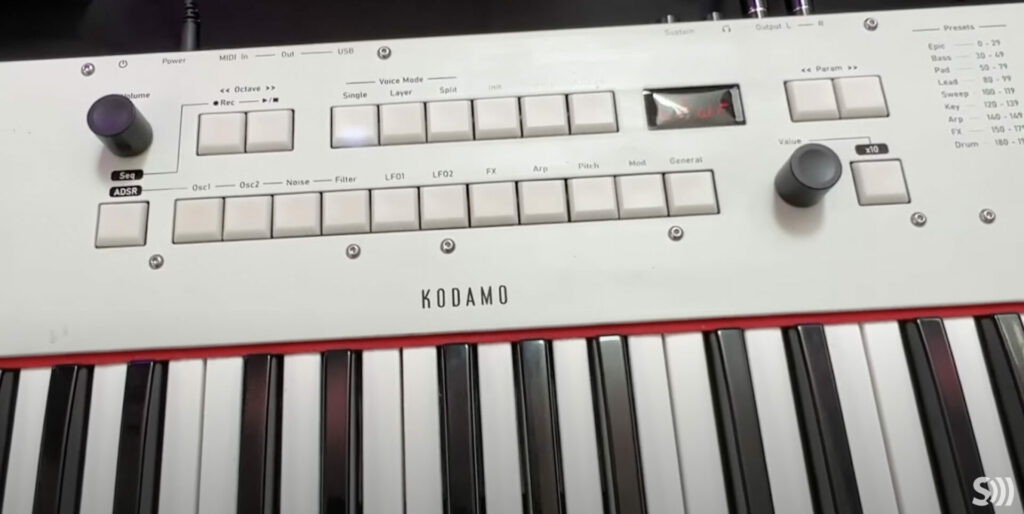
Cryptic Interface?!
What is striking is the very cryptic operation. We see a lot of buttons but only two knobs and a small numeric display. With such a new concept, I have doubts as to whether programming is fun here. Knobs, and a larger display… are definitely missing here. So that the whole synth becomes more hands-on and fun to play.
My French friends from Les Sondiers were at SoundMIT this weekend and made a video about the MASK 1.
At first look, an exciting new polyphonic Synthesizer. It’s great to see that developers dare to try new ideas in synthesis. The sound of the MASK 1 is also very pleasing and has a unique character. However, I don’t like the front panel design at all and I hope they decide to reject it and made a more hands-on version.
Kodamo MASK 1 is currently in development and will be available for 1790€ + VAT. Official release TBA.
More information here: Kodamo

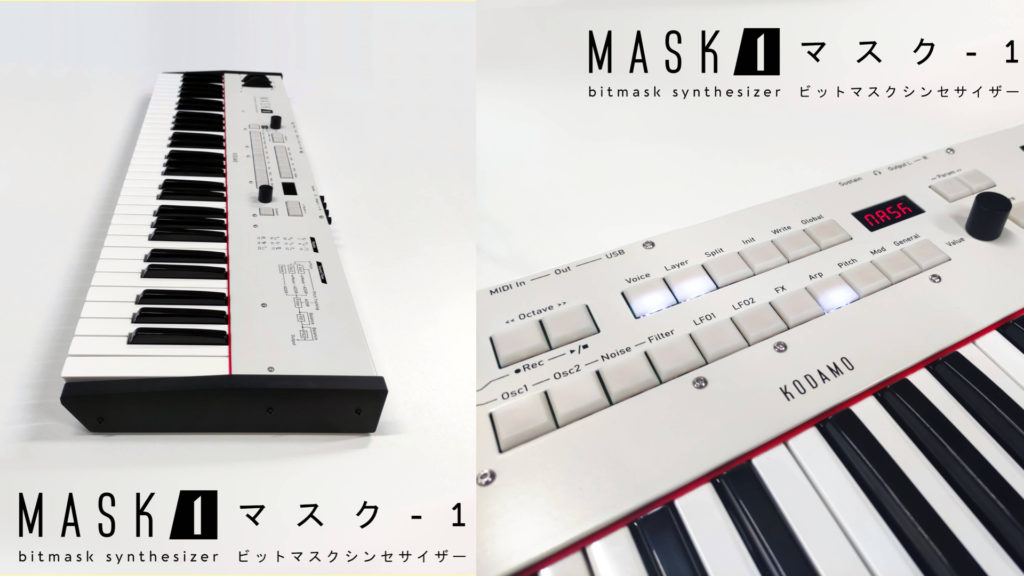
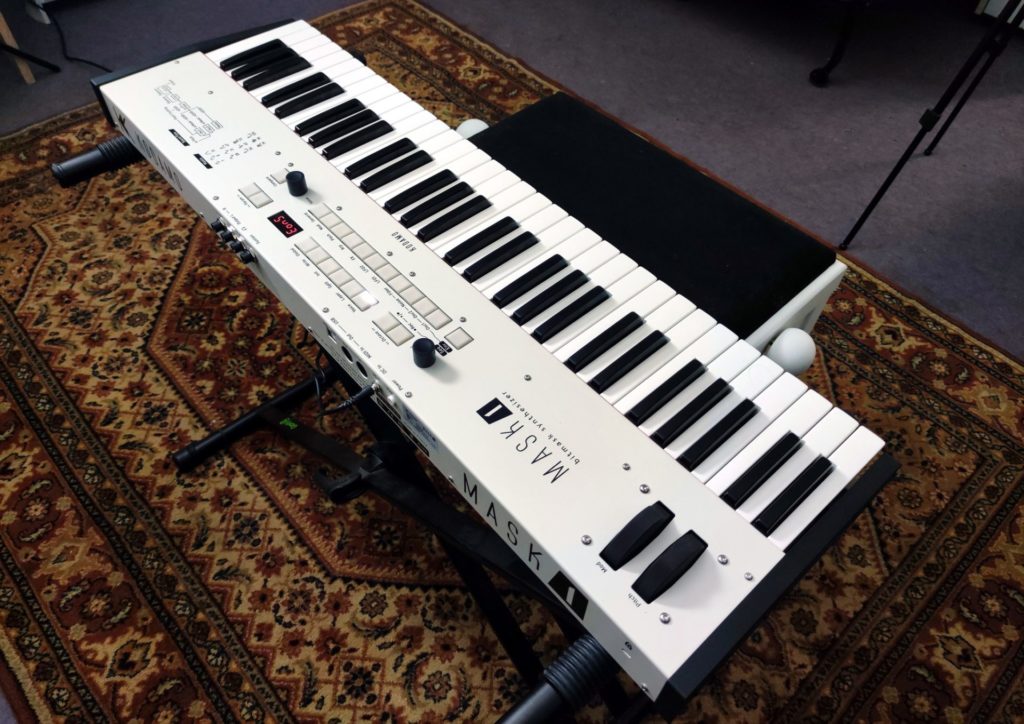
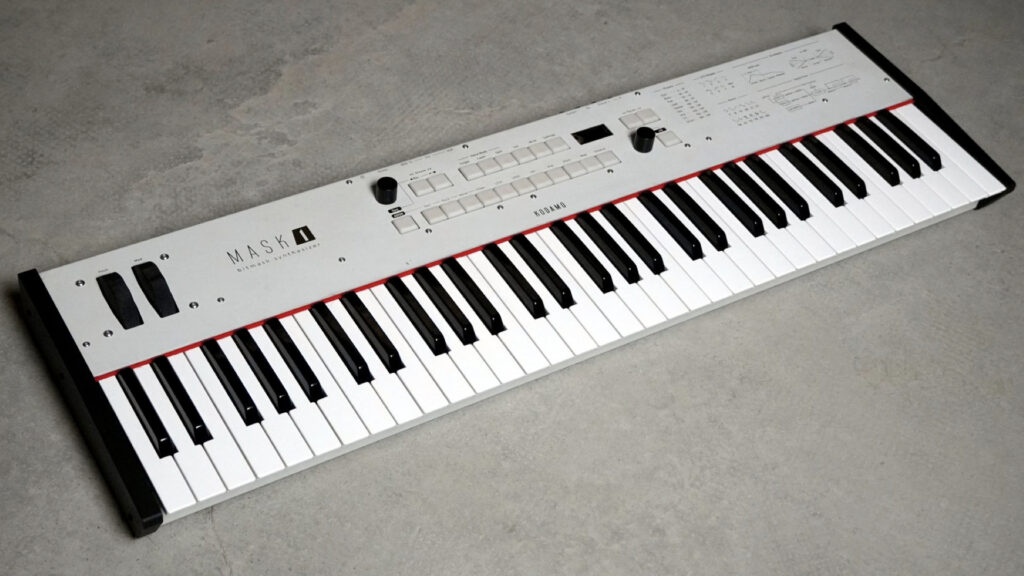
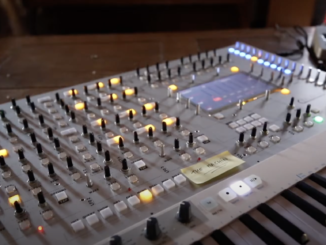
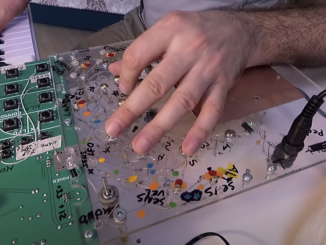
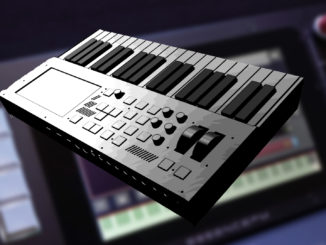
The idea reminds me of the Krishna Synth with its Frame Oscillator. It was a long time ago 🙂 Something tells me that Krishna Synth will be back 🙂
Very interesting. But that UI – in this day and age.. Auch! How very strange. Dare I say very French choice 😉 Kodamo claim it’s very intuitive, but seeing all parameters available it looks like a bad idea. Anyway let’s see. I want to want it. It’s refreshing with smaller companies doing their thing.
The UI is a truly awful choice for a company that has thus far been very forward thinking with their use of high res LCD screens. Sound vs UI needn’t ever be a compromise or choice.
This sounds great and I want it. The UI looks fine, seems like most parameters are one layer deep. I’ll happily take this over some other synth with crap paging systems.
If the stripped-down UI kept the price under $1000, that would be one thing, but in the quoted price range, I’d expect a lot more hands-on control.
If I understand the UI correctly, there is a button to select every parameter and a knob to enter the value. So you play with one hand and change one parameter at a time with the other. How much more hands-on control could you want? Even if it had 50 knobs, you can’t turn more than one at a time while playing.
I dare you name one synth with this type of UI that’s popular beyond it’s sound.. That’s right. It doesn’t exist. Most people simply dislike loosing full overview. Ask a friend 🙂
This sort of programming UI was popular in the early 90s. Remember how easy and intuitive it was to program the DX-7 ? Those great days might be coming back.
Isn’t this just a $20 iPad app?
well then every synthesizer is an app right? pls download me a Moog, now that’s real money saving!
Well, yeah, actually they are. If I was to blindfold you and play you sounds from an OG Mini Moog, a later model, a modern copy, a vst version, and iPad version and even a sampled one, in random order you’d be totally unable to say which is which.
So, s’true, unless you want physical controls, just get the cheap software.
It’s all just G.A.S. anyway.
On youtube yes, but in real life, no.
Sadly, I did exactly that to some colleagues, you know the type, “real analogue is warmer” fanbois.
Guess what? nope, they couldn’t tell the difference.
The problem for hardware is that software can not only emulate the synths well, it can emulate the faults too, dodgy caps, leaky transistors, transformer hum, connector crackle, everything.
Software is just…better.
Get a good USB controller with plenty of knobs on, job done.
Vintage gear is for synth pedants and most hardware is just weak bragging rights…and there’s a LOT of that around.
I would not necessarily disagree with much of what you had stated, however like anything else, it is largely dependent on the instrument, hard or soft based. And let us not forget one critical aspect here, all of these instruments run on hardware!
However the distinction is the quality of the sound whether it is analogue, digital, or a hybrid. The debate of analogue vs digital needs to be laid to rest, as the differences were blurred long ago and one technology does not necessarily or arbitrarily mean superior sound or sound creation.